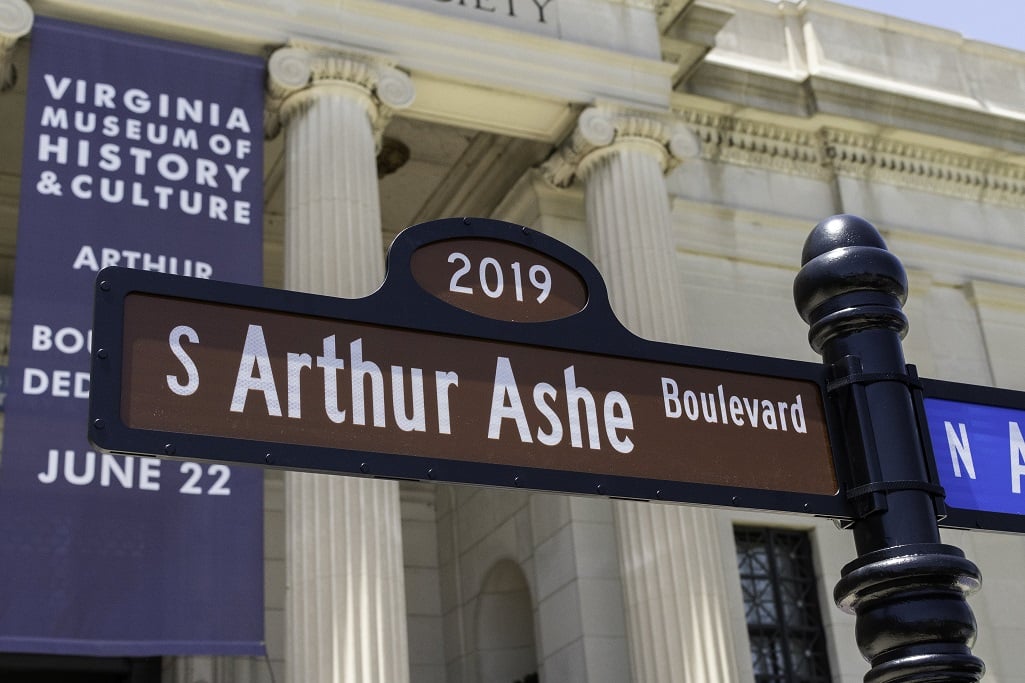Last weekend, government officials, civil rights leaders, and people from all across Virginia joined together to celebrate Richmond’s next step toward racial reconciliation.
It took nearly 30 years, but Richmond has officially renamed the street once known simply as Boulevard to Arthur Ashe Boulevard, in a symbolic action that elected officials hope will help advance Richmond towards becoming a more racially inclusive and representative city. Last weekend, the city celebrated on a bright, sunny Saturday morning with a dedication ceremony on the steps of the Virginia Museum of History and Culture.
“This stretch of State Route 161 will never be the same after today,” Richmond Mayor Levar Stoney said at the event. “Today Route 161 is getting an upgrade.”

“By naming this boulevard here today after Arthur Ashe we are once again parting with our darker past and embracing our brighter future,” Stoney continued. “We are making a pledge, that’s not simply in paint and steel street signs, but in our hearts.”
Hundreds of people gathered on the lawn of the Virginia Museum of History and Culture on Saturday in near 90 degree heat to witness the dedication of Arthur Ashe Boulevard and celebrate Richmond’s latest step toward racial reconciliation.
Leslie Stevenson from Glen Allen, Virginia said that attending the event felt like “witnessing history.”
“It was amazing,” said Stevenson. “I think everything was done really well… I think [the dedication] is just great for the community. I love how it’s brought the community together.”

According to Stoney, renaming the boulevard is an action that “brings both symbolic and real change” to the citizens of Richmond.
“Our city is transforming — it is changing its future and triumphing over its past.”
During the event, the Elegba Folklore Society gave two performances; the first kicked off the day’s celebrations and the second performance was given just before the unveiling countdown.
Additionally, the Sixth Mount Zion Baptist Church choir performed during the event. Sixth Mount Zion was founded in 1867 by Reverend John Jasper, for African-Americans after the Civil War.

In addition to Stoney, several other elected officials, including Virginia Governor Ralph Northam, Senator Tim Kaine, and Congressmen Donald McEachin gathered on the steps of the museum to share in the commemoration.
Georgia Congressman John Lewis, a noted civil rights leader who helped organize the 1963 March On Washington and was one of the original Freedom Riders, gave the keynote address. As he walked up to the mic, Lewis received a standing ovation from the crowd. Lewis then began an impassioned speech in which he urged the public to fight and speak up against injustices by getting into “good trouble, necessary trouble.”
Senator Tim Kaine described the boulevard as “a principle gateway into our city: and described the renaming as an “act of healing.”
“Naming is important, this is not a minor thing we are doing today,” said Kaine. “So many of the names that we live with were chosen by a tiny, tiny subset of people who do not represent the full community of our city, or state, or nation today. This is an act to rectify that.”
“Arthur Ashe Boulevard is a name chosen by and ably representing Richmond’s full community and that makes this a very great day for our city and hopefully a day that will be followed by many more such days.”

The new signs bearing the name “Arthur Ashe Boulevard” were unveiled on the steps of the Virginia Museum of History and Culture after a loud group countdown, at the end of which cannons shot purple streamers into the air.
Arthur Ashe was born in Richmond, Virginia in 1943. He was the first and only African-American male tennis player to win the U.S Open, Wimbledon, and the Australian Open. In 1968 he was ranked the number one tennis player in the world by the United States Lawn Tennis Association — the first African-American to be named so. Ashe is not only remembered for his accomplishments as a tennis player, but is also as an author, activist and humanitarian.
Growing up in Richmond, Virginia during the era of ‘separate but equal’, Ashe faced racial discrmination, exclusion, prejudice and segregation. As a child he was denied access to the tennis courts at Byrd Park, which was deemed whites only. As a result, Ashe had to practice on the segregated courts near his home instead. As a kid, he was also forbidden from competing against white youth in Richmond, and was unable to practice on the whites-only indoor courts.
During his career and throughout his retirement, Ashe was a zealous advocate for civil rights and racial equality worldwide. He worked to break down color lines and racial barriers in athletics and promote social change.
In addition to fighting racial discriminaion at home, Ashe also protested against apartheid, a political system of institutionalized racial segregation, in South Africa.
“Despite the adversity he faced right here in his hometown, by sheer talent courage (and) perseverance, Arthur Ashe brought change to the game of tennis, he brought change to this country…. And he brought change to this world,” said Stoney.

Unfortunately, Ashe’s health issues forced him to retire early. He underwent his first heart bypass surgery in 1979 at the age of 36. Then in 1983, he had to undergo a second bypass surgery and contracted HIV following a blood transfusion. In 1993, Ashe founded the Arthur Ashe Foundation for the Defeat of AIDS, helping to raise awareness and combat the misconceptions and stigma surrounding the disease.
During his retirement, Ashe also worked on a number of advocacy projects, and helped found the Association of Tennis Professionals and the National Junior Tennis League.
After his death on February 10, 1993, Ashe was posthumously awarded the Presidential Medal of Freedom by President Bill Clinton.
“Today we also honor a man who challenged the limitations society placed on men of his skin color and by doing so advanced the struggle for equality,” Governor Northam said Saturday.
“By breaking down racial barriers in tennis, Arthur Ashe achieved much more than sports fame. That legacy is why we are here to honor him today.”
Renaming the boulevard to Arthur Ashe Boulevard, was an idea that was previously introduced and defeated in 1993 and 2003. The latest and finally successful effort to rename the street was carried by Councilwoman Kim Gray.

David Harris Jr., Arthur Ashe’s nephew, who was also instrumental in the renewed push for the boulevard’s renaming, took the mic Saturday and shared an emotional speech with the crowd.
“Richmond, this is truly a spectacular and momentous day,” said Harris. “Today we are letting the world know racism, discrimination, exclusionary tactics, lack of investment in our children, education, and people is bankrupt.”
The dedication also coincided with the opening of a new exhibit, Determined: The 400 year struggle for Black Equality, at the Virginia Museum of History and Culture, which will run until March 20, 2020. The museum exhibit is part of the American Evolution program, a General Assembly program that recognizes the 400th anniversary of the arrival of the first enslaved Africans at Fort Monroe in 1619. According to American Evolution, they “partnered with the Virginia Museum of History and Culture to commission Determined to explore the African-American experience” in Virginia.

Later that evening, members of the Congressional Black Caucus held a State of Black America town hall meeting to discuss various issues affecting the African-American and black community in America today.
According to Mayor Stoney, June 22, 2019 is a day that represents hope for a new Richmond with a brighter and more inclusive future.
“And now at the intersection of our city’s past and present, it is our duty to take the next steps in our journey down the right path to lead the way for future generations,” said Stoney.
“We already have a map with a road to follow that will take us in the right direction. Let us follow it together. It’s called Arthur Ashe Boulevard.”
Top photo by Morgan Edwards



